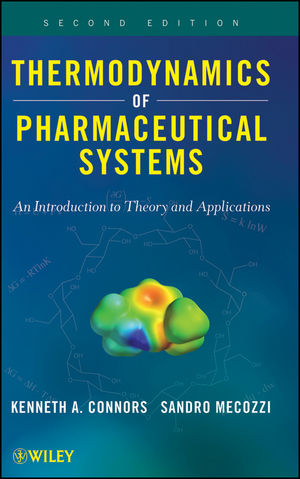Thermodynamics of Pharmaceutical Systems: An introduction to Theory and Applications, 2nd EditionISBN: 978-0-470-42512-1
Hardcover
384 pages
January 2010
 This is a Print-on-Demand title. It will be printed specifically to fill your order. Please allow an additional 10-15 days delivery time. The book is not returnable.
|
||||||
PREFACE TO THE FIRST EDITION.
0. Review of Mathematics.
0.1. Introduction.
0.2. Dimensions and Units.
0.3. Logarithms and Exponents.
0.4. Algebraic and Graphical Analysis.
0.5. Dealing with Change.
0.6. Statistical Treatment of Data.
Problems.
I BASIC THERMODYNAMICS.
1. Energy and the First Law of Thermodynamics.
1.1. Fundamental Concepts.
1.2. The First Law of Thermodynamics.
1.3. The Enthalpy.
Problems.
2. The Entropy Concept.
2.1. The Entropy Defined.
2.2. The Second Law of Thermodynamics.
2.3. Applications of the Entropy Concept.
Problems.
3. The Free Energy.
3.1. Properties of the Free Energy.
3.2. The Chemical Potential.
Problems.
4. Equilibrium.
4.1. Conditions for Equilibrium.
4.2. Physical Processes.
4.3. Chemical Equilibrium.
Problems.
II THERMODYNAMICS OF PHYSICAL PROCESSES.
5. Introduction to Physical Processes.
5.1. Scope.
5.2. Concentration Scales.
5.3. Standard States.
Problems.
6. Phase Transformations.
6.1. Pure Substances.
6.2. Multicomponent Systems.
Problems.
7. Solutions of Nonelectrolytes.
7.1. Ideal Solutions.
7.2. Nonideal Solutions.
7.3. Partitioning Between Liquid Phases.
Problems.
8. Solutions of Electrolytes.
8.1. Coulombic Interaction and Ionic Dissociation.
8.2. Mean Ionic Activity and Activity Coefficient.
8.3. The Debye–Hückel Theory.
Problems.
9. Colligative Properties.
9.1. Boiling Point Elevation.
9.2. Freezing Point Depression.
9.3. Osmotic Pressure.
9.4. Isotonicity Calculations.
Problems.
10. Solubility.
10.1. Solubility as an Equilibrium Constant.
10.2. The Ideal Solubility.
10.3. Temperature Dependence of the Solubility.
10.4. Solubility of Slightly Soluble Salts.
10.5. Solubilities of Nonelectrolytes: Further Issues.
Problems.
11. Surfaces and Interfaces.
11.1. Thermodynamic Properties.
11.2. Adsorption.
Problems.
III THERMODYNAMICS OF CHEMICAL PROCESSES.
12. Acid–Base Equilibria.
12.1. Acid–Base Theory.
12.2. pH Dependence of Acid–Base Equilibria.
12.3. Calculation of Solution pH.
12.4. Acid–Base Titrations.
12.5. Aqueous Solubility of Weak Acids and Bases.
12.6. Nonaqueous Acid–Base Behavior.
12.7. Acid–Base Structure and Strength.
Problems.
13. Electrical Work.
13.1. Introduction.
13.2. Oxidation–Reduction Reactions.
13.3. Electrochemical Cells.
13.4. pH Measurement.
13.5. Ion-Selective Membrane Electrodes.
Problems.
14. Noncovalent Binding Equilibria.
14.1. Introduction.
14.2. The Noncovalent Interactions.
14.3. Binding Models.
14.4. Measurement of Binding Constants.
14.5. Applications.
Problems.
APPENDIXES.
Appendix A Physical Constants.
Appendix B Kinetic Theory of Gases.
Appendix C Extrathermodynamic Relationships.
ANSWERS TO PROBLEMS.
BIBLIOGRAPHY.
INDEX.



